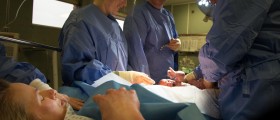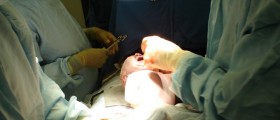
Preparations and options
These days, c-sections are becoming more personalized depending on the country you live in and your hospital. Often, you will be able to choose who will stay in the OR with you while you have your baby usually you can at least have your husband and one other support person, like your mom, a friend or a birth doula. Sometimes, you are even able to ask for dimmed lights, having the drapes lowered when it is time for your baby to be born, and even music! Your abdomen will be cleansed to create a sterile site, and often your arms are strapped down to prevent you from accidentally touching the site while you are being operated.
Anesthesia
Epidural anesthesia is now the norm for cesareans, especially planned ones. That is great, because you will be able to see your baby immediately. Some countries still practice general anesthetic for a c-section, and spinal anesthesia is also sometimes given.
Incision
There are various types of c-section incision. The low horizontal "bikini cut" is now popular. Classic incision refers to a vertical cut in your abdomen, and inverted T pretty much speaks for itself, and is sometimes applied where the baby is in a position that makes it difficult to get her out, like breech or transverse (sideways). The low horizontal position is the best for women who are hoping to have a vaginal delivery for a subsequent baby (see should you have a repeat c-section?). You can also request double sutures, which make your uterus stronger and may prevent uterine rupture in the future.
Birth
Your baby's birth should not take very long extracting a baby is pretty quick after the incision has been made. You should be able to see your baby immediately after birth, and might be able to have skin to skin contact in some situations. It is the stitching up after a c-section that takes the most time. You can expect this to take up to 45 minutes. For women who want to read about c-section recovery, our previous article how long will you need to stay in hospital after a c-section may be helpful.













Your thoughts on this
Loading...